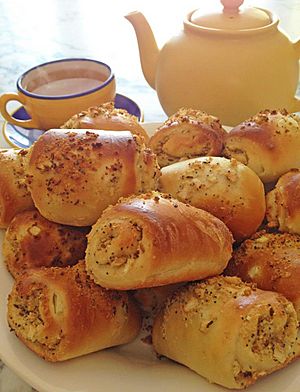Ratner's facts for kids
Quick facts for kids Ratner's |
|
|---|---|
| Lua error in Module:Location_map at line 420: attempt to index field 'wikibase' (a nil value). | |
| Restaurant information | |
| Established | 1905 |
| Closed | 2004 |
| Food type | Jewish kosher dairy (milkhik) restaurant |
| Street address | 138 Delancey Street, on the Lower East Side of Manhattan |
| City | New York City |
| State | New York |
| Coordinates | 40°43′6.56″N 73°59′12.77″W / 40.7184889°N 73.9868806°W |
Ratner's was a very famous Jewish and kosher dairy restaurant in New York City. It was located on the Lower East Side of Manhattan. Because it followed Jewish dietary laws (called kosher), it did not serve meat. This meant it was a good place to eat dairy foods. Many people thought it went well with Katz's Deli, which was famous for its meat dishes.
Contents
Who Owned Ratner's?
Ratner's started in 1905. It was founded by two people: Jacob Harmatz and his brother-in-law, Alex Ratner. They even flipped a coin to decide whose name would be on the restaurant sign!
In 1918, Alex Ratner sold his part of the restaurant to Jacob Harmatz. After that, the restaurant stayed in the Harmatz family. Jacob's son, Harold Harmatz, took over the business in the mid-1950s.
What Was on the Menu?
Brunch was the most popular meal at this dairy restaurant. When it was most popular, up to 1,200 people ate there every day.
Some of the famous foods included:
- Cheese blintzes (thin pancakes filled with cheese)
- Potato pancakes (called latkes)
- Hot onion rolls
- Split-pea soup
Other popular items were gefilte fish, poached salmon, kasha varnishkes, and vegetable borsht. Many of these recipes can still be found in cookbooks today. The onion rolls were especially famous. More than 1,500 onion rolls were baked daily, and 3,000 on Sundays! They were served at every table with every meal.
Where Was Ratner's Located?
The very first Ratner's was on Pitt Street in Manhattan. But in 1918, it moved to its most famous spot at 138 Delancey Street. This is where it stayed until it closed.
The Delancey Street Spot
The Delancey Street location was open 24 hours a day until 1975. This made it a popular place for late-night visitors. Many famous people visited, including actors, musicians, and even some well-known gangsters.
Some of the famous entertainers who were regular customers included Bill Graham, Al Jolson, Fanny Brice, Marty Allen, Eydie Gormé, Walter Matthau, Elia Kazan, Max Gordon, Groucho Marx, and Alan King. Gangsters like Bugsy Siegel and Meyer Lansky also visited the Delancey Street restaurant often.
Later, a back room at the Delancey Street location became a bar called "Lansky's Lounge." It was named after Meyer Lansky because he visited so often. This lounge has also closed, but another bar is now in that space.
The Second Avenue Spot
There was another Ratner's location at 111 Second Avenue. This one was run by other members of the Harmatz family. For many years, especially in the late 1960s and early 1970s, this location was even more popular than the Delancey Street one. This was because the area, known as the East Village, became a very trendy and creative place.
The Soup Cart
Ratner's also had a soup cart! It operated only on weekdays at the corner of 6th Avenue and 46th Street. The cart sold different kinds of meatless soups. It operated until the late 1990s.
Ratner's Products Today
Even though the restaurants are closed, you can still find some products with the Ratner's name. A company called King Kold now owns the brand. They make and sell items like blintzes, crepes, potato pancakes, veggie pancakes, pierogies, matzo balls, and soups. These products are sold in supermarkets.
Cookbooks from Ratner's
In 1975, Jacob Harmatz's daughter, Judith Gethers, and her niece, Elizabeth Lefft, wrote a cookbook. It was called The World Famous Ratner's Meatless Cookbook. Ms. Gethers was a cookbook author and helped other chefs with their books too.


